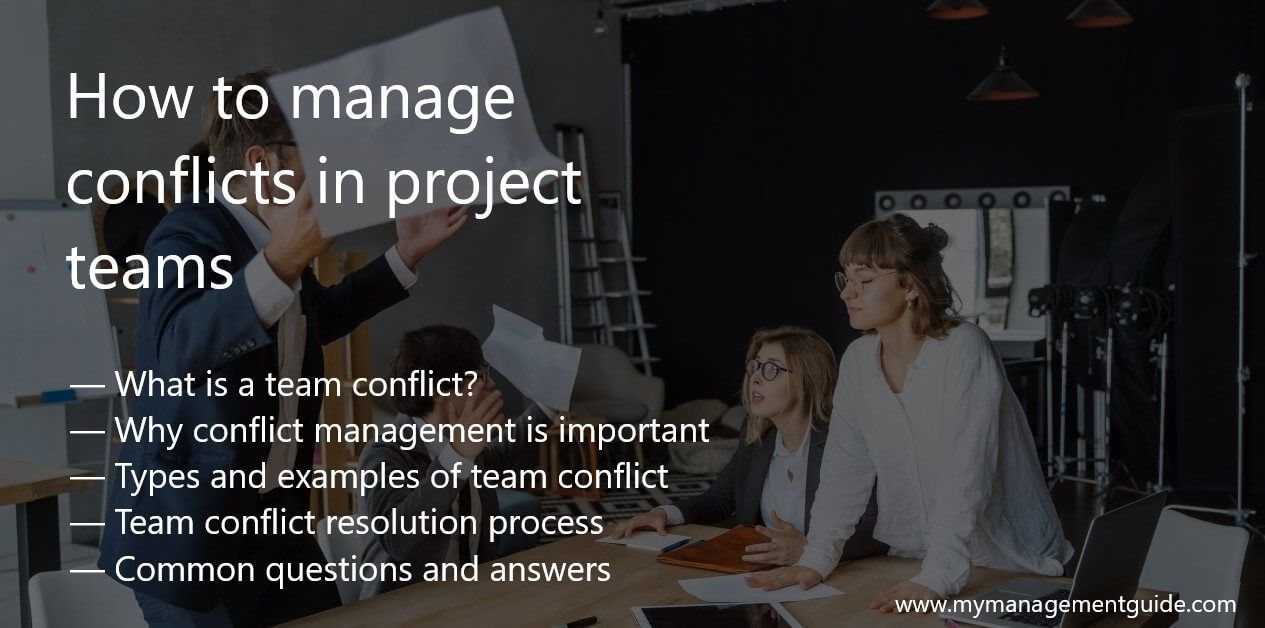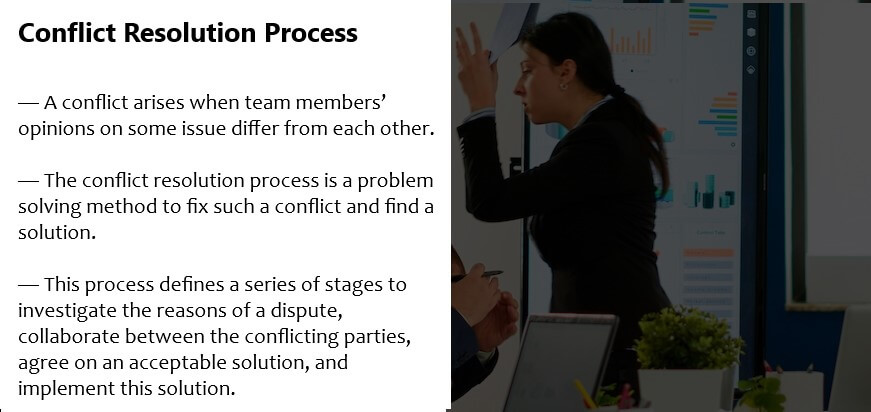Team Conflict in Project Management: Definition, Classification, Resolution Process

 In project management, team conflicts define a form of disagreement between team members regarding some tasks, processes or individuals involved with the project. If not resolved properly, destructive conflicts lead to negative consequences and performance deterioration. Constructive conflicts, on the other hand, lead the team to growth and improvement in their performance.
In project management, team conflicts define a form of disagreement between team members regarding some tasks, processes or individuals involved with the project. If not resolved properly, destructive conflicts lead to negative consequences and performance deterioration. Constructive conflicts, on the other hand, lead the team to growth and improvement in their performance.
In this article, we will present a definition of team conflicts, their importance, different types and examples in project management. Finally, we will give a description of the team conflict resolution process and list the ground rules of conflict management.
Read in this article:
- What is a team conflict?
- Why conflict management is important
- Types of team conflict
- Examples of project team conflicts
- Team conflict resolution process
- Common questions and answers
This article will be helpful for project managers, team leaders and anyone who needs to know how to handle team conflicts in project environments and workplaces.
1. Definition: What is a Team Conflict?
Although conflicts are inevitable, project managers and HR professionals should strive to reduce the likelihood of conflict occurrence. They want to mitigate the negative impact of group conflicts and try to increase the positive impact of those disagreements.
We define team conflict as follows:
Team Conflict is an undesirable, interpersonal problem that occurs between two or more members of the same project team, and affects results of teamwork, so the team does not perform at an optimum level.
Project team conflicts are caused by the situation when the balance between perceptions, goals, or/and values of the team members is upset. Therefore, these people can no longer work together effectively and no shared goals can be achieved in this team environment.
Typical sources of team conflict
Let’s explain typical sources of group conflicts.
- Perceptions. what a person perceives in a situation is not necessarily identical to the reality. Therefore, the team members may have different interpretations of the exact same situation or event without being able to reach a mutual understanding. This can be a source of team disagreements.
- Values. People have different values and principles in life, and these differences may lead them to disagree when it comes to how they behave at workplaces. If their values lead them to take opposite positions when dealing with a particular issue, this difference in opinion can create conflicts within the team environment.
- Goals. People may want to achieve something, but they might have different reasons for doing so. This is also a source of team conflicts, because it triggers disagreements between members about the best way to accomplish this task.
When conflicts originate in any of these factors, they can lead to damaging consequences for teams and project performance.
2. What is the Importance of Conflict Management in Teams?
Although conflicts can be seen as negative factors, they can also help teams to reach better results. This statement is true if we manage them correctly.
- Conflict management is important for effective teamwork in a project environment mainly because conflicts can have a positive impact in this situation.
- Furthermore, project conflict management is the way to reach a shared goal and an important process that can help teams achieve a better performance.
- Performing collaborative work is very difficult for individuals because they have to deal with differences. The more complicating the project tasks are, the bigger the number of differences may be between people involved with this project.
In other words, team conflicts will be more common when the project task complexity increases. Therefore, team members will have to work more closely together and there may be more argumentation going on between them.
In spite of these facts, team conflicts should not be ignored or neglected.
3. Classification: Three Types of Team Conflict
Classification of employee conflicts is the foundation of effective team conflict management, because by having identified a type of conflicts, team leaders are able to choose right conflict resolving tools and apply appropriate conflict management strategies.
In this context, let’s classify disagreements between team members.
— 3.1. By Functional Attribute
First of all, conflicts between team members can be functional and dysfunctional.
- Functional conflicts are disagreements that do not significantly affect team performance, so the team remains functional and is able to produce desired results.
- Dysfunctional conflicts are those disagreements between employees that disrupt teamwork and prevent team members from following shared goals, so the entire team becomes dysfunctional and no desired results can be produced.
The listed types of team conflict are defined considering the functional attribute of project teams.
— 3.2. By Origin of Conflict
Another way to classify employee conflicts refers to focusing on the origin of conflicts, or investigating how a conflict has evolved. Following this idea, the next sources of group conflicts are to be considered:
- Values of team members. Each team member has its own values yet he/she should follow values of the team. When a disagreement between the values appears, a conflict may arise.
- Goals versus Expectations. Often improperly set goals do not relate to actual expectations, then a group conflict may take place.
- Roles and responsibilities. If right people are not assigned to right responsibilities and roles, an employee conflict is likely to arise.
- Lack of resources. Every team has to work using limited resources – this situation increases the risk of group conflict occurrence.
These team conflict types let team leaders use their conflict resolution skills (like Intervention and Feedback) to look at the original reasons of a group conflict.
— 3.3. By Behavior
Besides this way of investigating team conflicts, there is another way to classify conflicts into the following types:
- Constructive team conflicts. Such conflicts arise when team members grow personally and increase their qualification. Constructive team conflicts result in a solution to a problem and create cohesiveness between team members.
- Destructive team conflicts. They arise when the team problem solving process fails so no solution is generated and the problem still exists. Destructive conflicts between team members defocus group effort and divert energy away from prioritized activities. Such conflicts demoralize the team and make it polarized.
By understanding all the listed conflict types as well as the given definition, team leaders can achieve better conflict management because they will be able to investigate the nature of team conflicts and generate the right resolution.
4. Examples of Project Team Conflicts
The following examples help to understand the previous classification of team conflicts in project management environments.
— 4.1. Constructive Team Conflicts
Constructive conflicts can take place in all team types, yet it is more likely to appear in non-virtual teams.
Let’s look at this example:
A project team consisting of three members was working together for a year. These were a programmer, a product designer and a project manager. At this time, program code was developed, product design documentation was prepared, and the project plan was finished. The tasks of this team were well-coordinated, so no conflicts occurred in their work for the previous several months.
The client wanted to have the final product earlier than it could be delivered by this team, so he introduced changes into the schedule and delivery date so that they could perform faster. As a result, the project schedule broke down and the product would be delayed because all three members performed in different ways to develop it in less time period given by client.
At this time, the project manager had to intervene with team members in order to find a common solution for delivering product on the specified deadline. The video-conferencing system was used for this purpose. Through conversation, the project team ultimately found a solution for their problem.
Thus, conflicts between team members in this case were constructive because they led to a successful resolution of their problem and ultimately helped them deliver product on time.
— 4.2) Destructive Team Conflicts
A destructive team conflict can occur in any team type. Below is an example.
A project team consisted of two employees, an architect and an engineer. Sometimes, the colleagues work hard to satisfy their superior manager’s demands, but do not remember about their own task.
They are worried about working overtime for their superior, but they never think how they can manage their tasks without extra time. This is one of the most common destructive functional conflicts among teammates in IT project management.
Here is another example:
A company was developing a new product with a deadline of one year. The project team consisted of a project manager, a designer and a programmer. In this team, the project manager was dissatisfied with the work of programmer because he did not have enough time to perform his tasks. The programmer thought that all the fault lies on design group whose product was not ready for software development.
The result of this conflict was that product was developed too late so the client could not use it as expected.

5. Team Conflict Resolution Process
There are a few conflict management strategies for resolving disagreements and disputes between teammates within a project team.
Different experts have different advice on this topic, but they all agree that the most effective way to resolve conflicts is through collaboration between conflicting parties.
What is a Conflict Resolution Process?
As mentioned, conflicts arise when team members’ opinions on some issue differ from each other. The conflict resolution process is a problem solving method to fix such a conflict and find a solution. This process defines a series of stages to investigate the reasons of a dispute, collaborate between the conflicting parties, agree on an acceptable solution, and implement this solution.
Usually, it is a team leader’s responsibility to set up a conflict resolution process for their team in order to address group conflicts in the workplace.
In project management, the conflict resolution process can be divided into two categories: intervention and feedback. The project manager is in charged of managing this process (acting as a conflict manager).
— 5.1. Intervention
Through this approach, the team leader needs to intervene with the conflicting parties in order to find their common solution. Such an approach is more applicable to large teams with 10+ members.
The team leader needs to perform the following steps:
- Assess the team conflict scale. Team leaders (project managers) need to gauge the scale of the conflict in order to investigate potential losses and risks.
- Identify the conflicting parties. It allows the team leader to have a clear view of the issue and to determine who caused it.
- Select a tactics to intervene with conflicting parties. Team leaders need to choose an appropriate way to resolve conflicts. Three main approaches are available:
- Team members need to negotiate the conflict resolution directly, but this is relevant only to small project teams.
- The team leader needs to be involved in negotiations between conflicting parties.
- The team leader can ask other team members to participate in negotiations between conflicting parties. The choice of the mediator team member should be based on the conflict type. The mediator helps to negotiate with conflicting parties, so it should be possible to resolve the conflict types.
- Solve the conflict by mediation or negotiation.
— 5. 2. Feedback
Conflict resolution with this approach is based on feedback. Each team member who participated in the team conflict needs to give responses to each other’s statements or actions during the conflict.
The goal of the Feedback approach is to maintain good relationships between teammates, because team members can work well together if they have positive relationships with one another (even though they may be in conflict).
This approach helps the team leader to investigate the nature of the conflict with conflicting parties. Then, he/she can make them aware of information about a specific problem and how it can be solved. It is also important for the team leader to help conflicting parties be aware of each other’s opinions and try different approaches for their resolution.
The project leader can use the following methods to provide feedback to the conflicting parties:
- Inviting them for a meeting with other project members if they have conflicts with their partner.
- Providing one-on-one counseling if there are serious conflicts on work styles or personal relationships between teammates. Using counseling will help these parties change their behavior so that they do not have further conflicts with their partners or other team members.
- Creating regular meetings with project members to understand the different aspects of their conflicts.
- Providing team building activities for teammates.
Project leaders can use conflict resolution process based on feedback or intervention according to the situation they face. They may also use both approaches together in order to deal with team conflicts.
6. Common Questions and Answers about Team Conflicts
— 6. 1. What is the basis for most team conflicts?
- Lack of clearly defined job expectations and goals
- Lack of trust and respect between team members
— 6.2. What are some precautions for preventing conflicts?
Having clear expectations of team members is probably the most important thing to prevent team conflicts. Develop a common ground understanding about each other’s role and tasks, and follow a simple structure of decision making process will help team members to reduce unnecessary conflicts by improving their communication skills.
— 6.3. What is the definitions of an effective conflict resolution strategy?
- no team members should resign their commitment to the project before its completion
- no one should continue working on the project without receiving all required information
- no one should act against the other team member’s decision
— 6.4. How to safely handle the fear of conflict team dysfunction?
To handle the fear of conflict team dysfunction, it is indispensable for team members to take responsibility for their own actions, propose other solutions to the conflict and cooperate with the team leader and other team members.
— 6.5. What are the implications of conflict on teamwork?
Conflict can have a negative, positive or neutral effect on teamwork. It is always important for teammates to attack problems rather than each other. By being constructive rather than destructive, team members will be able to keep their focus on the project goals instead of squandering time and energy on conflicts with others.
— 6.6. What are some problems contributing to project conflict management?
A project team leader’s inability to handle grievances effectively is one of the most significant reasons of ineffective conflict management in projects. He/she should have confidence in himself/herself and be able to set up clear work instructions, so that employees will follow them without any question, which will eliminate unnecessary conflicts with their coworkers.
Conclusion: Learn to Handle Future Conflicts
Successful resolution of any problem depends on team leaders’ ability to identify the nature of conflicts, investigate all common causes and therefore determine the best resolution methods for them.
In order to do it correctly and safely, the team leader should always use some mechanisms for gathering more information from all sides. These include video conferencing systems, team-building activities, surveys and other techniques described above in this article.
In conclusion, it is important that a project manager teaches employees to avoid conflicts with their coworkers by using some simple skills for conflict management and design their own unique strategy of resolving team conflicts more effectively.













